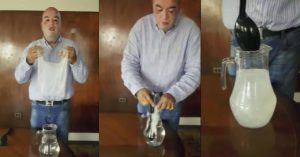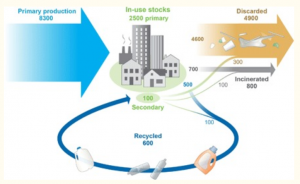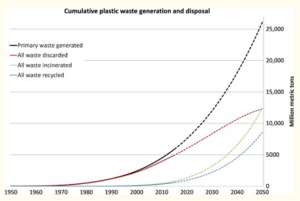The Plastic Pandemic:
Ever since its incarnation, plastic has become one of the most ubiquitous man-made inventions ever, with 8.3 billion metric tons produced to date. An average person uses 85 kg of plastic every year and it has become integrated into our daily lives, from containers that keep our food, to bags to hold our groceries. With the ever increasing demand for plastic, it begs the question, where does it all go? Common plastics are not biodegradable, and their durability and resistance makes it almost impossible for it to decompose naturally.
A study done by Geyer et al., found three different fates for all plastic: recycled, incinerated, or accumulated in landfills or the natural environment. The most widely talked about solution for solving the plastic epidemic is recycling. In principle, recycling can be extremely beneficial, but in reality, it merely delays final disposal. In fact, only around 9% of plastic is recycled. To put it another way, we only recycle one plastic bag for every 200 we use. With the sheer amount being produced each year, plastic production would have to cease in favor of recycling to make any remarkable impact. However, this is not feasible because there would not be enough material to meet market demand. Another method is thermal destruction. Around 12% of plastic is incinerated and is the only way to permanently eliminate it. However, the emissions produced from this process can cause negative environmental and health impacts. Lastly, the most widespread method of disposal (with 79%) is simply discarding plastics in landfills or in the environment. This, of course, has severe effects on our planet. Plastic debris has been found in all major oceans, and it is estimated that 4 to 12 million metric tons of plastic waste entered the marine environment in 2010 alone.
Innovated Alternatives:
We need to rethink the effectiveness of current methods of plastic waste disposal. Earlier in 2018, Chile passed a law to ban the widespread, commercial use of plastic bags. In addition, a Chilean company called Solubag has come up with a biodegradable plastic bag, made with a type of alcohol (derived from limestone) that dissolves in water. Even the dissolved plastic bag is harmless as demonstrated in the video below. This is definitely a step in the right direction

Solubag creator demonstrating their biodegradable plastic bag’s ability to dissolve in water (credit to Positivr)
In North America, businesses are also making changes to reduce plastic waste. In particular, Starbucks plans to eliminate all plastic straws from their shops by 2020. Their replacements are polypropylene lids, which are recyclable plastics; unlike straws that are too small and light to be recycled. If this transition is successful, this could potentially eliminate more than one billion plastic straws a year.

Starbucks’ new lids could replace all plastic straws from their shops by 2020 (credit to The Guardian)
Our Plastic-Wrapped Future:
We definitely need to find solutions to the plastic problem. Plastic waste is exponentially increasing and current disposal methods cannot contain it. Geyer et al. estimate that 12 billion metric tons of plastic waste will be in landfills or the natural environment by 2050. If left unresolved, plastic accumulation could rapidly engulf the planet.
Written by: Nathan Chua


